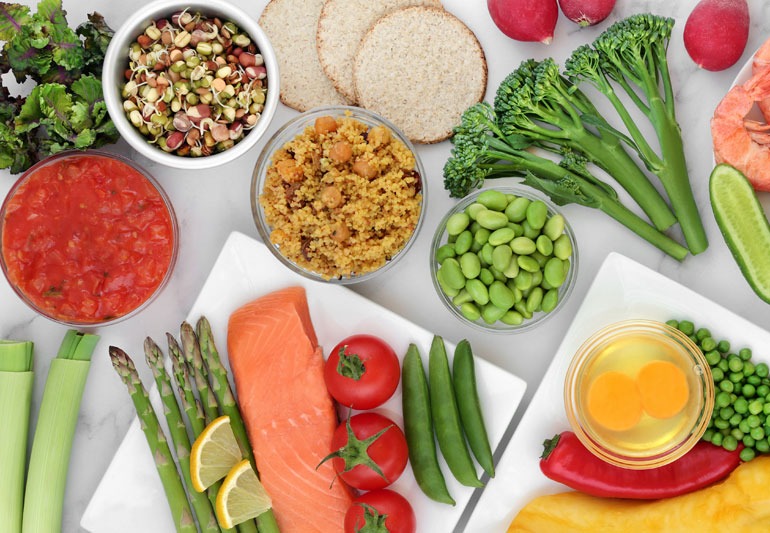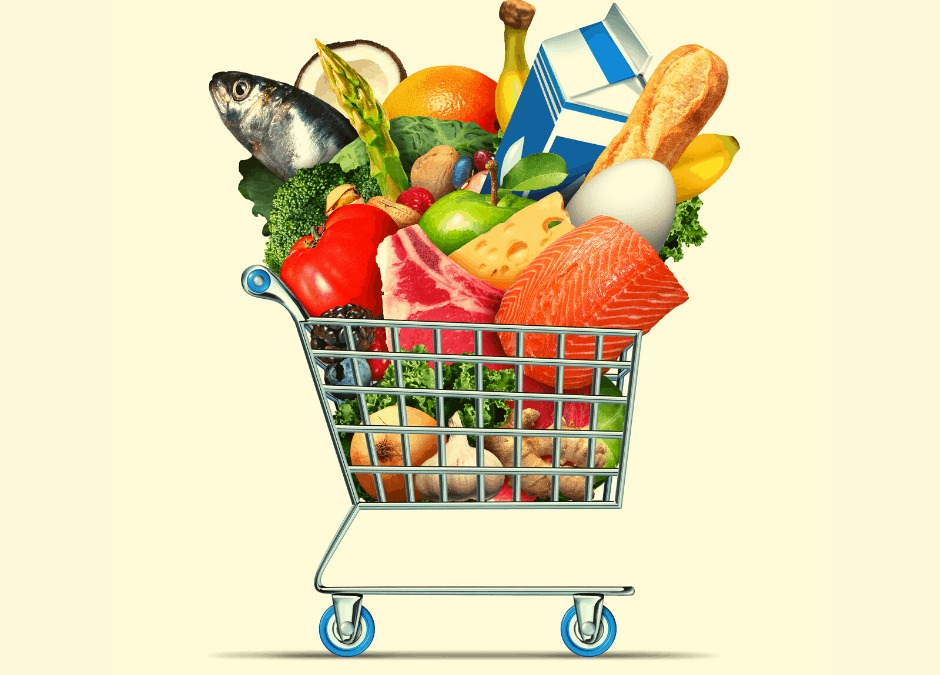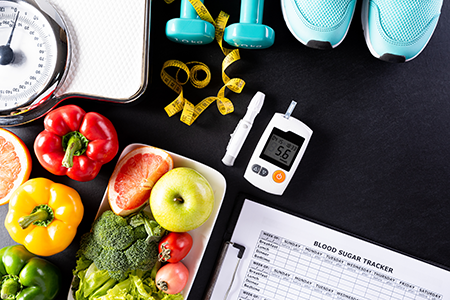Diet & Nutritions
 1.The Psychology of Eating
1.The Psychology of Eating
By making better food choices, you may be able to manage compulsive eating behaviors and weight gain. You can also experience feelings of calmness, high energy levels or alertness from the foods you eat.
What is the psychology of eating?
What we eat affects how we feel. Food should make us feel good. It tastes great and nourishes our bodies. If you eat too little or eat too much, however, your health and quality of life could be affected. This can result in negative feelings toward food.
By learning how to make healthier and more mindful choices, you may be able to manage compulsive eating, binging and weight gain. By taking charge of your appetite, you may also gain a feeling of calm, high energy levels and alertness from the foods you eat.
Overall, there are many benefits to changing deep-seated, unhealthy eating habits, such as:
- An increase in energy level and alertness.
- A more positive relationship with food.
- Improved health.
- Easier movement.
- Improved body image.
While we often have the best intentions to eat healthier, this is often a challenging task.
What factors influence our eating behaviors?
Experts believe many factors can influence our feelings about food and our eating behaviors. These factors include:
- Cultural.
- Evolutionary.
- Social.
- Family.
- Individual.
- Economic status.
- Psychological.
Many people use food as a coping mechanism to deal with such feelings as stress, boredom or anxiety, or even to prolong feelings of joy. While this may help in the short term, eating to soothe and ease your feelings often leads to regret and guilt, and can even increase the negative feelings. You aren’t actually coping with the problem causing the stress. Further, your self-image may suffer as you gain weight, or you may experience other undesired effects on your health, such as elevated blood sugars, cholesterol levels or blood pressure.
What role does psychology play in weight management?
Psychology is the science of behavior. It is the study of how and why people do what they do. For people trying to manage their weight, psychology addresses:
- Behavior: Treatment involves identifying the person’s eating patterns and finding ways to change eating behaviors.
- Cognition (thinking): Therapy focuses on identifying self-defeating thinking patterns that contribute to weight management problems.
What treatments are used for weight management?
Cognitive behavioral treatment is the approach most often used because it deals with both thinking patterns and behavior. Some areas that are addressed through cognitive behavioral treatment include:
- Determining the person’s “readiness for change”: This involves an awareness of what needs to be done to achieve your goals and then making a commitment to do it.
- Learning how to self-monitor: Self-monitoring helps you become more aware of what triggers you to eat in the moment, and more mindful of your food choices and portions. It also helps you stay focused on achieving long-term progress.
- Breaking linkages: The focus here is on stimulus regulation, such as not eating in particular settings, and not keeping unhealthy food choices in your home. Cognitive behavioral treatment also teaches distraction — replacing eating with healthier alternatives — as a skill for coping with stress. Positive reinforcement, rehearsal/problem-solving, finding social support and changing eating habits are specific techniques used to break linkages.
What does cognitive behavioral treatment involve?
Cognitive therapy addresses how you think about food. It helps you recognize self-defeating patterns of thinking that can undermine your success at eating healthier and managing your weight/weight loss. It also helps you learn and practice using positive coping self-statements.
Examples of self-defeating thoughts include:
- “This is too hard. I can’t do it.”
- “If I don’t make it to my target weight, I’ve failed.”
- “Now that I’ve lost weight, I can go back to eating any way I want.”
Examples of positive coping self-statements include:
- “I realize that I am overeating. I need to think about how I can stop this pattern of behavior.”
- “I need to understand what triggered my overeating, so I can create a plan to cope with it if I encounter the trigger again.”
- “Am I really hungry or is this just a craving? I will wait to see if this feeling passes.”
What strategies will help me manage my weight?
To lose weight, it’s helpful to change your thinking. Weight management is about making a lifestyle change. It’s not going to happen if you rely on short-term diet after diet to lose weight.
To be successful, be aware of the role that eating plays in your life, and learn how to use positive thinking and behavioral coping strategies to manage your eating and your weight.
To help get you started, here are a few tips:
Tips for healthy eating
- Don’t skip meals.
- Do plan meals and snacks ahead of time.
- Do keep track of your eating habits.
- Do limit night eating.
- Do drink plenty of water.
- Do delay/distract yourself when experiencing cravings.
- Do exercise instead of eating when you are bored.
- Do be attentive when you eat. Don’t eat while watching TV, working, driving or standing.
- Do only eat in certain settings (kitchen table).
- Do watch your portion sizes.
- Do allow yourself to eat a range of foods without forbidding yourself a particular food.
- Do give yourself encouragement.
- Do look for a support person to help you stay motivated and accountable.
- Do be gentle with yourself! Try not to beat yourself up when you lapse.
- Do think of eating healthfully as a lifestyle change.
- Do use the scale mindfully. Weigh yourself no more than once a week.
- Do make healthy food choices.
The food diary
A food diary is a tool to record in detail:
- What food you eat.
- When you eat.
- How you feel when you’re eating.
- What you are doing (if anything) while you are eating.
The diary can help you get a better understanding of what you eat and why you eat it. It also can help your doctor, therapist, or dietitian work with you to make the necessary changes for successful weight management.
 2.Why Diet is Important ?
2.Why Diet is Important ?
Making changes to your diet is a key part of managing type 2 diabetes.
You may have heard of the “ABCs of diabetes.” This refers to three aspects of your health that should be well-controlled in order to manage your diabetes: A1C (a blood test that measures your average blood sugar level over the past few months), Blood pressure, and Cholesterol. Keeping your blood sugar at or near your goal level helps decrease the risk of complications that can affect the eyes, kidneys, and nerves. Keeping your blood pressure and cholesterol levels under control helps reduce your risk of cardiovascular (heart) disease, which is a common complication of type 2 diabetes.
Many factors affect how well a person’s diabetes is controlled. You can reduce your risk of complications by following your health care provider’s guidance around diet, exercise, blood sugar monitoring, and medication regimens. Dietary changes are typically focused on eating nutritious foods and getting to (and maintaining) a healthy weight. If you take insulin, you may also need to be consistent about what you eat and when.
Having to pay careful attention to your diet can be challenging. It can help to work with a dietitian to create a plan that is tailored to your specific situation (including what diabetes medications you take), lifestyle, and personal preferences.
TYPE 2 DIABETES, DIET, AND WEIGHT
If you are overweight or have obesity, losing weight can improve blood sugar control and lower your blood pressure and cholesterol levels.
Losing weight — Your health care provider can help you set goals for losing weight. For a person who is overweight or has obesity, a typical goal is to lose 5 to 10 percent of their body weight. For a person who weighs 240 pounds, this would mean losing 12 to 24 pounds. Losing even more weight can sometimes reduce the blood sugars to the normal range. But even losing a little bit of weight can help improve your health; in fact, cutting back on the number of calories you eat each day can lower your blood sugar levels even before you actually lose weight.
The initial approach to weight loss usually involves eating fewer calories and exercising regularly. There are other strategies that may be appropriate for people who are having trouble losing weight, including medications and surgery. More information about losing weight is available separately.
TYPE 2 DIABETES AND CARBOHYDRATE CONSISTENCY
Carbohydrates are the main energy source in the diet and include starches, vegetables, fruits, dairy products, and sugars. Most meats and fats do not contain any carbohydrates.
Carbohydrates directly affect your blood sugar level, whereas proteins and fat have little impact. Eating a consistent amount of carbohydrates at each meal can help to control your blood sugar levels, especially if you take certain oral diabetes medications or long-acting insulin.
There are different ways to make sure you eat a consistent amount of carbohydrates throughout the day, including carbohydrate counting and exchange planning.
Carbohydrate counting — A dietitian can help you figure out the number of carbohydrates you need each day based on your eating habits, weight, nutritional goals, and activity level. The way carbohydrates are divided up for each meal or snack will depend on your personal preferences, the timing and spacing of your meals, and which diabetes medications you take. “Carb counting” is particularly important if you take insulin, as you will need to adjust your insulin doses according to the carbohydrate content of what you are planning to eat. However, even if you do not take insulin, carb counting can help you keep your blood sugar levels from getting too low or too high.
The number of carbohydrates in a particular food can be determined by reading the nutrition label, consulting a reference book, website, or smartphone app, or using the exchange system.
 3.Nutritions And Diabetes
3.Nutritions And Diabetes
Nutrition and physical activity are important parts of a healthy lifestyle when you have diabetes. Along with other benefits, following a healthy meal plan and being active can help you keep your blood glucose level, also called blood sugar, in your target range. To manage your blood glucose, you need to balance what you eat and drink with physical activity and diabetes medicine, if you take any. What you choose to eat, how much you eat, and when you eat are all important in keeping your blood glucose level in the range that your health care team recommends.
Becoming more active and making changes in what you eat and drink can seem challenging at first. You may find it easier to start with small changes and get help from your family, friends, and health care team.
Eating well and being physically active most days of the week can help you
- keep your blood glucose level, blood pressure, and cholesterol in your target ranges
- lose weight or stay at a healthy weight
- prevent or delay diabetes problems
- feel good and have more energy.
What foods can I eat if I have diabetes?
You may worry that having diabetes means going without foods you enjoy. The good news is that you can still eat your favorite foods, but you might need to eat smaller portions or enjoy them less often. Your health care team will help create a diabetes meal plan for you that meets your needs and likes.
The key to eating with diabetes is to eat a variety of healthy foods from all food groups, in the amounts your meal plan outlines. The food groups are:
- Vegetables
- Nonstarchy: includes broccoli, carrots, greens, peppers, and tomatoes
- Starchy: includes potatoes, corn, and green peas
- Fruits—includes oranges, melon, berries, apples, bananas, and grapes
- Grains—at least half of your grains for the day should be whole grains
- includes wheat, rice, oats, cornmeal, barley, and quinoa
- examples: bread, pasta, cereal, and tortillas
- Protein
- lean meat
- chicken or turkey without the skin
- fish
- eggs
- nuts and peanuts
- dried beans and certain peas, such as chickpeas and split peas
- meat substitutes, such as tofu
- Dairy—nonfat or low fat
- milk or lactose-free milk if you have lactose intolerance
- yogurt
- cheese
Eat foods with heart-healthy fats, which mainly come from these foods:
- oils that are liquid at room temperature, such as canola and olive oil
- nuts and seeds
- heart-healthy fish such as salmon, tuna, and mackerel
- avocado
Use oils when cooking food instead of butter, cream, shortening, lard, or stick margarine.
What foods and drinks should I limit if I have diabetes?
Foods and drinks to limit include
- fried foods and other foods high in saturated fat and trans fat
- foods high in salt, also called sodium
- sweets, such as baked goods, candy, and ice cream
- beverages with added sugars, such as juice, regular soda, and regular sports or energy drinks
Drink water instead of sweetened beverages. Consider using a sugar substitute in your coffee or tea.
If you drink alcohol, drink moderately—no more than one drink a day if you’re a woman or two drinks a day if you’re a man. If you use insulin or diabetes medicines that increase the amount of insulin your body makes, alcohol can make your blood glucose level drop too low. This is especially true if you haven’t eaten in a while. It’s best to eat some food when you drink alcohol.
When should I eat if I have diabetes?
Some people with diabetes need to eat at about the same time each day. Others can be more flexible with the timing of their meals. Depending on your diabetes medicines or type of insulin, you may need to eat the same amount of carbohydrates at the same time each day. If you take “mealtime” insulin, your eating schedule can be more flexible.
If you use certain diabetes medicines or insulin and you skip or delay a meal, your blood glucose level can drop too low. Ask your health care team when you should eat and whether you should eat before and after physical activity.
How much can I eat if I have diabetes?
Eating the right amount of food will also help you manage your blood glucose level and your weight. Your health care team can help you figure out how much food and how many calories you should eat each day.
 4. Nutritional guidelines to prevent, control, and reverse type 2 diabetes
4. Nutritional guidelines to prevent, control, and reverse type 2 diabetes
Figuring out what to eat when diagnosed with type 2 diabetes might be one of the most challenging problems. As nutrition plays such an important role, it is therefore essential to be directly involved in developing your treatment plan, actively seek information, and educate yourself in this matter.
Eat a diet low in saturated fats
Fat in the bloodstream reaches the muscle cells and builds up there, creating toxic breakdown products (free radicals) that cause inflammation and dysfunction of mitochondria. This phenomenon is called lipotoxicity. All of these processes block the “insulinsignaling” action4 and lead to an accumulation of sugar in the bloodstream. The influence of fat on “insulin function” was shown by infusing fat into people’s blood and observing how “insulin resistance” raised considerably. Conversely, removing fat from the bloodstream leads to a drop in “insulinresistance”.6 In many cases, the relationship between fat passing from the bloodstream into the muscles and the associated level of “insulin resistance” can also be tracked using MRI technology7.
Palmitate (palmitic acid) and oleate (oleic acid) are two types of fats that have a direct impact on type 2 diabetes:
- Palmitic acid — a saturated fat (found in meat, dairy, and eggs) that impairs “insulin secretion”, increases “insulin resistance”, and may be toxic to the pancreatic cells
- Oleic acid — a monosaturated fat (found in nuts, olives, avocados) that may have a protective effect against diabetes
One of the largest studies that investigates meat consumption in relation to body weight, called Epic-Panacea, proves that, on average, if two people eat the same number of calories, the person eating more meat gains significantly more weight.
The same study identified poultry as being potentially the most fattening meat, determining that the more poultry people ate over a fourteen-year period, the more their BMI (Body Mass Index) increased.
Consume legumes as they help control blood sugar
People who eat significant amounts of legumes (beans, chickpeas, and lentils) tend to weigh less. This diet is shown to have the same effect in terms of weight loss and blood sugar control as calorie cutting, with the additional benefit of improved cholesterol and “insulin regulation”.
Fenugreek, fava beans (Vicia faba), and mung beans, for example, have been shown in multiple studies to have a beneficial effect on reducing blood sugar and cholesterol levels.
Plants with a positive impact on diabetes management
Moringa olearias considered the “miracle plant” for lowering blood sugar levels. Two studies on animals and three on humans11 have shown that the leaves of Moringa oliefera have a positive impact on type 2 diabetes as they help decrease cholesterol levels, reduce inflammation, and protect the pancreatic cells. Moreover, Moringa contains four of the plant substances (phytochemicals) with the highest impact on hyperglycemia and dyslipidemia.
The research groups that received a daily dose of Moringa oleifera leaf powder had significantly reduced diabetes markers compared to the groups that did not receive any Moringa oleifera supplementation.
The combination of phytochemicals derived from cranberry, oregano, rosemary, and rhodora rosea has also been proven to be efficient in the management of diabetes and the improvement of pancreatic function.
In addition, studies on humans have determined that consuming algae can decrease the risk of diabetes, while studies on animals have shown that Chlorella vulgaris has the potential to inhibit the development of “insulin resistance”, while marine spirulina significantly alters the diabetic indicators. A diet enriched with a combination of zinc and spirulina has been established to have beneficial effects on cholesterol and glycemic and triglyceride levels.
Randomized, placebo-controlled, and double-blind studies on humans have proven that cinnamon might also be a viable option for regulating blood glucose and blood pressure. In one study, for example, the intake of a minimum of 2 g of cinnamon for 12 weeks significantly reduced the main markers of diabetes.
5. Reducing inflammation helps control and reverse type 2 diabetes
Inflammation is a natural reaction in the human body, a way that it deals with infections and injuries.
 It aims to repair the damaged tissue. Normally, it is a short-term reaction, but because of oxidative stress and imbalances in the immune system, it can become chronic.
It aims to repair the damaged tissue. Normally, it is a short-term reaction, but because of oxidative stress and imbalances in the immune system, it can become chronic.
When the immune system comes into contact with an external factor (a pathogen or food), this triggers the release of pro-inflammatory cytokines. These cytokines can directly enhance “insulin resistance” in muscle and liver cells.
Carotenoids, a class of phytonutrients (“plant chemicals”) found in red, yellow, and orange fruits and in vegetables, have been shown to reduce inflammation. Various studies have demonstrated that when a person has a higher concentration of carotenoids in their body, they have a lower risk of diabetes.31 In other words: a plant-based diet can reverse type 2 diabetes.
6. Lifestyle as a means to prevent and reverse type 2 diabetes
A sedentary lifestyle is one of the most important risk factors for type 2 diabetes. Research studies have shown that engaging in a moderate exercise program results in a reduction of diabetes markers (hemoglobin A1c) in eight weeks.
| Type of Exercise | What Happens in the Body |
| Aerobic exercise | Muscles use glucose to function, and aerobic exercise therefore causes the level of glucose in the blood to decrease. A single session increases “insulinaction” and glucose tolerance for more than 24 hrs (up to 72 hrs). |
| Strength training | This results in lower fasting blood sugar levels 24 hrs after exercise, with greater reductions depending on the volume and intensity of the exercise |
 According to the Human Movement Sciences Department at Old Dominion University, Virginia, a combination of aerobic exercise and strength training is the most effective way to manage blood sugar levels. New “musclemass” increases the sugar uptake from the blood and its usage as fuel, whereas aerobic exercise increases “insulinaction”.
According to the Human Movement Sciences Department at Old Dominion University, Virginia, a combination of aerobic exercise and strength training is the most effective way to manage blood sugar levels. New “musclemass” increases the sugar uptake from the blood and its usage as fuel, whereas aerobic exercise increases “insulinaction”.
Special attention should be paid when patients have other diabetes complications (e.g., circulatory disease, neuropathy, or retinopathy). Furthermore, if the blood sugar levels are not kept under control, patients can develop hyper- or hypoglycemia during exercise. In this case, it is advisable to adjust or closely monitor medication.
Even if it might seem to be a logical and easy treatment option, an intensive blood-sugar-lowering therapy was proven to actually increase subjects’ mortality, by accelerating ageing and promoting cancer, obesity, atherosclerosis, and inflammation in the arteries.
Despite the large number of studies on the impact of nutrition in preventing and reversing type 2 diabetes, this disease is only becoming more prevalent. Only one in three prediabetic patients reports ever being told by the doctor to exercise and improve their diets.
Nevertheless, the World Health Organization stresses that diabetes can be treated, and its consequences avoided or delayed with diet, physical activity, medication and regular screening and treatment for complications.
